Goodreads vs. Hardcover: Which is Right for You?
By Adam Fortuna
Since social networks began emerging in the late 2000s, one niche has been more wrought with difficulty than any other – book websites.
Goodreads was first to market and set the tone of what book websites could be. They were perhaps the first to introduce the idea of a “want to read” list online – a topic that resonated with millions of readers.
A few years later Goodreads was sold to Amazon for around $125 million. This brought one more book site under their banner. Coupled with Audible and Kindle, Amazon owns the top sites to sell physical books, read digital books, listen to audiobooks and track what you read.
Since then Goodreads has inched forward adding occasional new features and removing them. The fundamentals of the site today are very similar to a decade ago.
Hardcover, on the other hand, was formed a year ago in 2021. We’re a small group of readers with a mission to create an independently owned book tracker that solves the same problems as Goodreads – but with new twists that readers didn’t even know they were missing.
But which is right for you? Which one has what you’re looking for? Let’s dig into what Hardcover and Goodreads offer and try to help you decide.
To kick things off, here’s a full overview of how these compare. Keep on reading for an explanation of what each feature means.
| Goodreads | Hardcover | |
|---|---|---|
| Year Founded | 2006 | 2021 |
| Age | 18 years | 2.5 years |
| Owner | Amazon | 100% employee-owned |
| Public API | Deprecated REST API | GraphQL API |
| Data Export | CSV | JSON Google Sheets/Airtable sync on the roadmap |
| Reading Statuses | • Want to Read • Currently Reading • Read • Custom statuses (lower-kabob-case-only) | • Want to Read • Currently Reading • Read • Did not Finish |
| Personal Book Tracking | • Dates started and finished • Private notes • Specific edition • Ownership | • Dates started and finished • Private notes • Edition • Ownership • Reading format (audio, text) |
| Lists | • Status Lists • Manual Lists • Listopia | • Status Lists • Manual Lists • Ranked Lists • Prompt Lists |
| List controls | • Custom columns • Table, shelf views • List stats • Sorting | • Custom columns • Table, shelf card views • List stats • Sorting + sorting by match percentage • Filter by any field • Filter by genre, mood, content warning, or custom tags • Group by option • Drag and drop reordering • Save settings per-list |
Rating & Reviews | • 1, 2, 3, 4, 5 stars • Reviews w/custom formatting for spoilers, etc. | • 0.5 – 5 stars (with half stars) • Reviews with a custom editor for spoilers, etc. |
| Social Side | • Follow Readers • Friends Readers (2-way friendship) • Follow Authors • Friend social feed | • Follow readers • Followers feed • For You feed |
| Example Profile | Adam Fortuna /user/show/2419634-adam-fortuna | Adam Fortuna /@adam |
| Privacy | • Profile visibility to public, logged in only, friends only • Book reviews and saved books are public. • Lists can be public, logged in only, or friends only | • Profile visibility to public, followers only, or only you • Book activity can be set as public, followers only, or private • Lists can be public, followers only, or private |
| Recommendations | • Similar books • Recommended books | • Match Percentage • Similar User Percentage • Recommended books |
| Notifications | ✅ | ✅ |
| Direct Messaging | ✅ | ❌ |
| Book Discoverability | • Book Feed • Lists • Recommendations • Readers Choice Awards | • Book Feed • Lists • Prompts • Trending books • Books by genre • Books by mood • Books by tag |
| Book Database | Backed by Amazon & thousands of librarians | Backed by external APIs, our librarians & the community |
| Genre & Taxonomy | • Nested, ranked genres per book | • Flat, ranked genres per book • Content Warning tags • Mood tags • Custom tags All genres, content warnings, moods, and custom tags can be marked as a spoiler. |
| Community | • Social Feed • Book Clubs • Groups • Discussions • Ask an author • Trivia • Quizes | • Social Feed • Prompts • Discord • Bookle We’re working on discussions next! |
| Stats | • Basic list stats • Reading stats • Year in review • Compare readers | • List stats • Reader Stats • Year in review • 2023 Year in Books |
| Goals | • One yearly book goal | • Multiple date-based goals • By pages read or number of books |
| Apps | • Website • iPhone App • Android App | • Website • Mobile website view • iOS & Android Apps |
Ok, that was a lot. Let’s compare these one by one with some screenshots!
Book Tracking
In a poll shared on Reddit, the number one feature that people use on Goodreads (by a large margin) is book tracking. When readers hear about a book, they’ll add it to their “Want to Read” and come back to it later.
Both Hardcover and Goodreads allow for setting your status on every book. By default, Goodreads has statuses for “Want to Read”, “Currently Reading” and “Read”. Hardcover has these plus a “Did Not Finish” status.
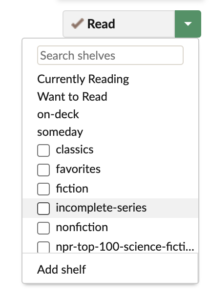
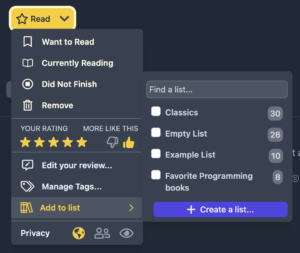
Goodreads also allows for creating custom statuses where a book can belong to exactly one status. The downside is these are lowercase with dashes instead of spaces. Not the prettiest look.
Hardcover doesn’t have a concept of custom statuses. Instead, Hardcover has a concept of lists. You can add a book to any number of lists similar to how you can add a book to any number of Shelves on Goodreads. If there’s a status missing on here that you think we should include, we’d love to hear what and why.
The most significant difference between Hardcover and Goodreads is in what is actually being tracked. On Goodreads, you’re tracking a specific edition of a book whether you select one or not.
On Hardcover, we have a concept of a “book” that has many “editions”. When you initially set a status, you’re setting it on the book in general, not a specific edition. This allows you to see reviews for all editions in one place.
Later on, we want to enable tracking per edition. In that case, you’ll still track the book, but readers who want to can specify the exact edition they read (side note: when we import data from Goodreads we’re already saving this edition).
Winner: Hardcover, unless you want additional custom statuses or specific edition tracking.
Rating
Both Goodreads and Hardcover allow for rating a book, but we think Hardcover makes it a little easier. Anywhere you see the book, you’ll usually see the book button (the one above where you can set the status, rate it, and add it to lists.
Goodreads only allows for rating books with integers from 1 to 5. There are no half stars.
Hardcover allows for half stars from 0.5 stars up to 5 stars.
Winner: Hardcover!
Starred Books
Hardcover has one more way to highlight books – by starring them. You can star any book you’ve saved with a status. Your starred books show up at the top of any lists they appear in by default.

Winner: Hardcover
Reviews
Reviews are a core feature of any book tracking platform. Goodreads gives you a text box and from there you can go wild. You can include gifs, links, and whatever you want. In order to do more than just write text, you’ll need to learn their formatting code which includes tags for spoilers, linking to other books and authors, and inserting images.
Hardcover uses a WYSIWYG (what you see is what you get) editor. You can add basic formatting (bold, italic, code, headers, ordered lists, unordered lists, and quotes) as well as mark parts of your review as a spoiler.
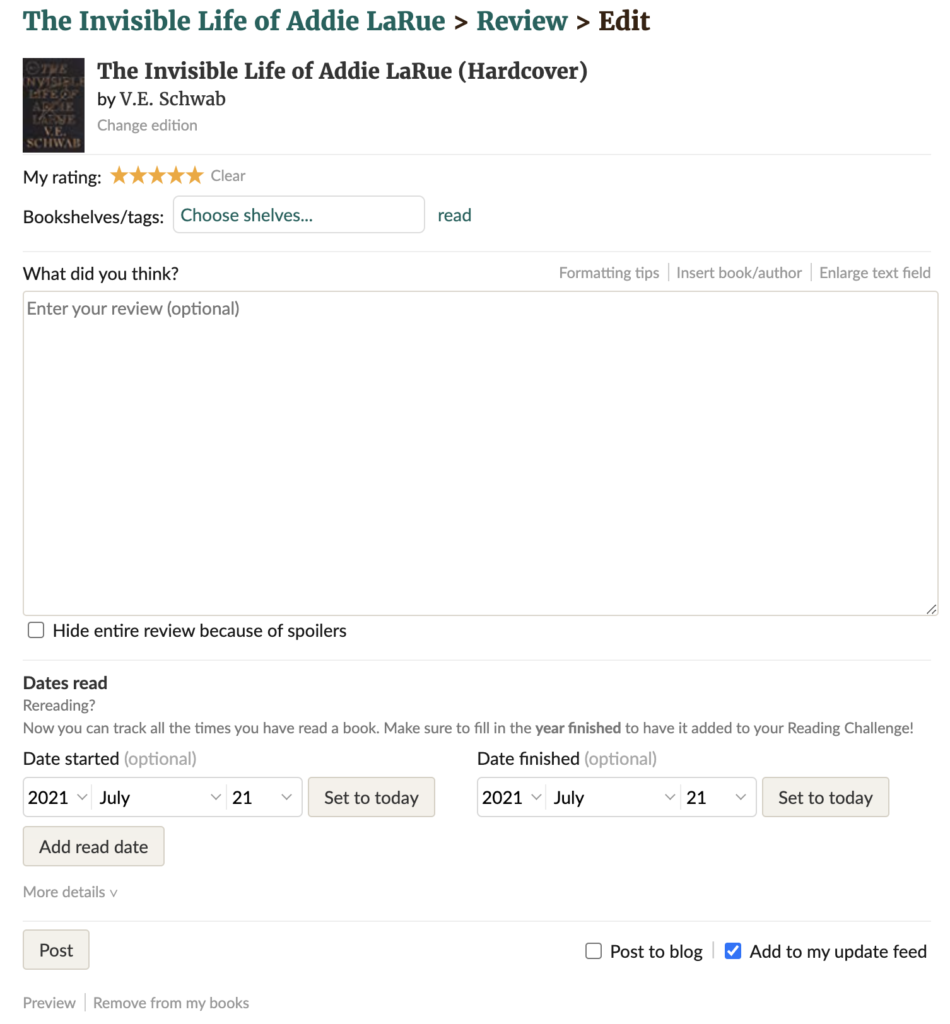
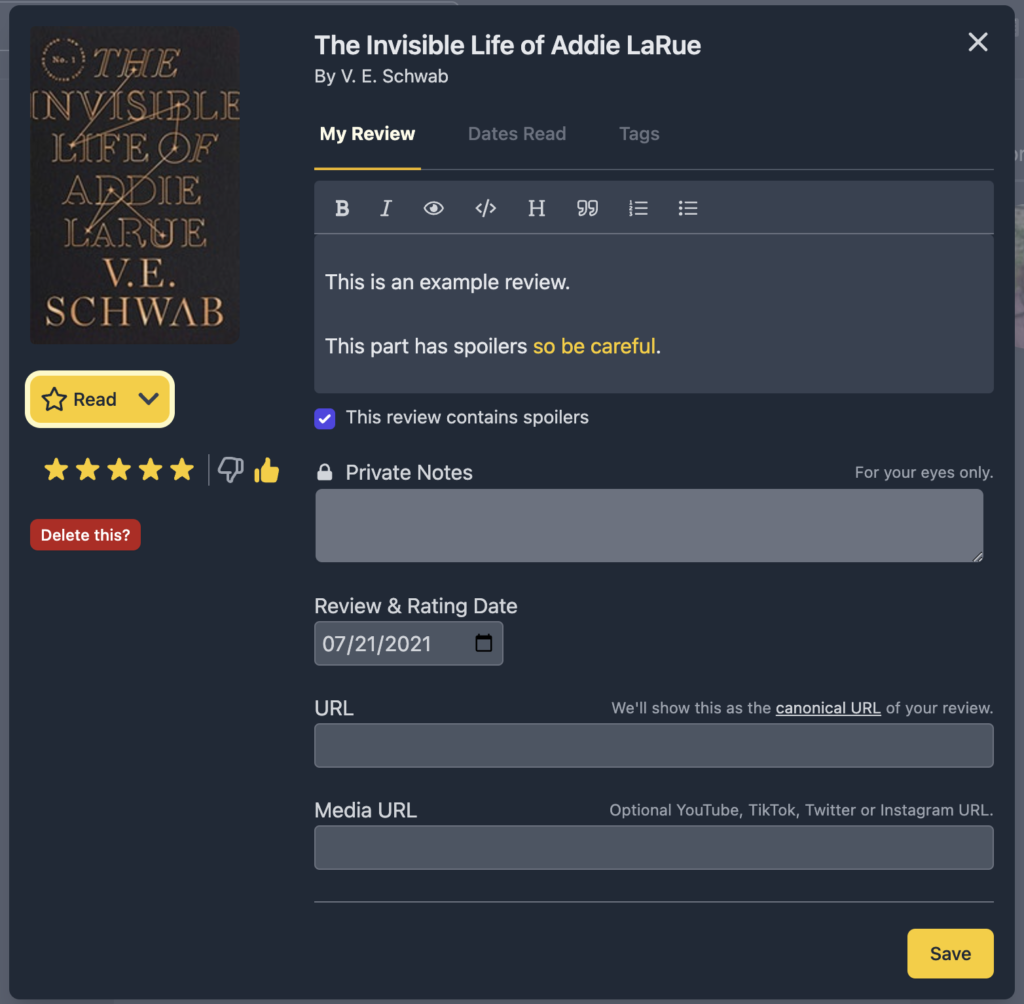

One thing we’re excited about for Hardcover is that you can set a canonical URL to a blog post or review outside of Hardcover in any review as well as a media URL – usually an Instagram or TikTok. We’ll link to these and embed them on Hardcover.
If you’re a blogger and want to repost all of your reviews to Hardcover, we want to help you grow!
Winner: If you like gifs Goodreads, otherwise Hardcover.
Date Tracking
Both Goodreads and Hardcover allow for tracking when you started and finished a book. Unfortunately, Goodreads data export doesn’t include the start dates for when you began reading each. As a result of this, Hardcover won’t have your “start dates” for any books you import. We’ve made it possible to add these manually.

Hardcover lets you set multiple dates read and the format you read the book in – text or audio.
Winner: Tie. Both allow tracking of start and end date. Goodreads allows tracking down the edition. Hardcover lets you specify format instead (text vs audio).
Lists
Lists of books take many forms each with a different goal in mind. Some people use lists to categorize books they want to read, others only after they’ve read them.
We’ve thought a LOT about lists. That includes talking to more than 50 readers we’ve tried to come up with a solution that works for casual readers who barely touch them all the way up to power users who want full control over their data. The result of this was our recent Airlists release.
Goodreads has three types of lists: exclusive shelves (want to read, read, currently reading), shelves, and lists. Any book can be on exactly one exclusive shelf, any number of shelves, and any number of lists.
Hardcover has exclusive statuses as well (with the same statuses plus “Did not finish”) as well as lists. There’s one additional dimension to Hardcovers lists: tags. Each tag has a category and a value. For example: “Genre: Science fiction”, “Content Warning: Death”, “My custom category: read twice”.
Both Hardcover and Goodreads have a concept of an open list that other readers can add books. Goodreads calls these “Lists” (part of Listopia), Hardcover calls them Prompts.
This is a lot to remember, so here’s a quick key for what terms both sites use for these.
| Goodreads | Hardcover |
|---|---|
| Exclusive Shelf | Status Lists |
| Shelf | List |
| List | Prompt |
Hardcover allows for searching any status list or Manual list by any tags you’ve added, or by the most popular tags added by everyone.
Status Lists
Both Goodreads and Hardcover create a page with all of the books you’ve marked as being in a status. Goodreads calls them “Exclusive shelves”, and Hardcover calls them “Your Books By Status”. They’re effectively the same thing – showing all books you’ve marked with a given status.
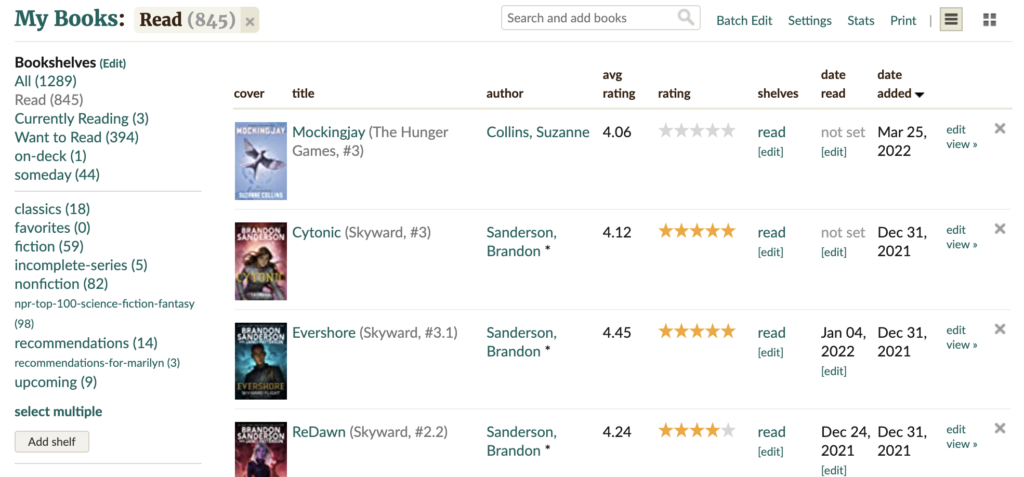

Both Hardcover and Goodreads create lists for each of your statuses that can be shared with other people. For both you can select which columns you want to see, toggle between table and shelf view, and change sorting.
Hardcover’s lists go a step further:
- Toggle between different views – Table, Card, or Shelf view
- Change size between small, medium and large
- Filter by any criteria in the table
- Group results by any of these
My favorite way to use this feature is with match percentage. You can head over to your “Want to Read” page and sort it by match percentage. That’ll highlight what books you’ve already saved that Hardcover thinks you’ll enjoy the most.

Winner: Hardcover
Lists
The next type of lists are ones you create to organize or share books in a group. These can be ones other readers created like The New York Times’s 50 Best Memoirs of the Past 50 Years or NPR Top 100 Science Fiction Fantasy Books.
Adding books to lists is similar on both Hardcover and Goodreads. You can add straight from the book button on both. Hardcover also allows adding books to lists from the search results or the list page.
In terms of features, Goodreads Shelves have the same functionality as their Exclusive Shelves.
Hardcover lists have a few additional features.
- Ranked lists – When you create a list you can decide if order matters in the list or not. For example, in the NPR Top 100 Science Fiction books list, those are ordered from most votes to least votes. The list owner can drag and drop books to create the order they want.
- Saved Settings – The owner of a list can change the sort order, view and more to get the list view they want. Once they save that view, they can share it with anyone else and others will see the same thing. This is great if you want to share a list with a specific goal in mind.
- Bookmark Lists – See a list someone else created that you love? Bookmark it for later.
What I love most about lists is how they give you the opportunity to express yourself. Just look at how Bridgerton fans can explore the 12 Historical Romance Novels Bridgerton Fans Will Burn For list.

Winner: Hardcover by a lot.
Prompts
Goodreads has a concept of “Lists”, where you can create a list then anyone can vote on books to add to the list.
Hardcover has a similar concept, but we call them “Prompts”.
In both cases, there’s a single question, prompt or topic, and the wisdom of the crowds adds books to that list until the most popular books rise to the top.
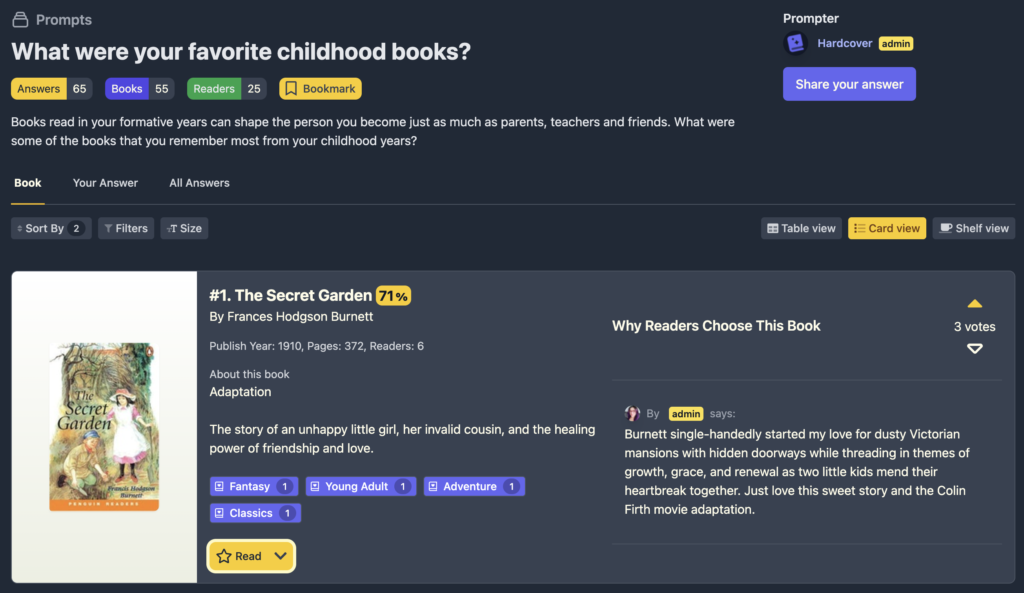
At the moment only the @hardcover user can create Prompts. Once the community grows more we’ll allow anyone to create them.
These could be as general or personal as you want and as public or private as you want. You could create a prompt asking your friends what their favorite recent books are. Genre-readers could ask about recommended books in a specific niche. Influencers could create Prompts for what they should read next.
This is just the start. We hope prompts will be an amazing way to share your favorite books with the community while also finding new favorites.
Winner: Tie for the feature, Goodreads for the community size, and past prompts/lists, Hardcover for the future of this idea.
Book Data
Let’s face it, all the features in the world aren’t going to matter if the books you’re looking for aren’t there. When you hear about a book and want to add it to your want-to-read list, you shouldn’t have to go in and manually add it to the system. That’s too much work to ask most readers to do (and I myself wouldn’t want to do it very often).
Goodreads has Hardcover outmatched here by an order of magnitude. By some accounts, Goodreads has 1.5 billion different books. Many of those are duplicates and multiple editions of the same book.
Their concept of a “book” is an edition of a book. The Hobbit, for example, has 1,299 different editions. That doesn’t even include compilations (sets where The Hobbit is one of many books).
Hardcover has roughly 30 million editions of books, and roughly 500,000 total unique books. We actively try to merge duplicates together so that there is one canonical page for every book on the platform.
Take The Way of Kings as an example.
On Hardcover, the URL is /books/the-way-of-kings. Easy to understand what’s going on there. We have 15 different editions of the book right now.
On Goodreads the URL is /book/show/7235533-the-way-of-kings – still enough to understand it, but not exactly easy to tell if you’re at the “right” version of the book. They have 85 different editions including many in other languages that Hardcover doesn’t have each with its own page.
It’s unlikely that Hardcover will ever have the book database that Goodreads has. Goodreads has Amazon’s data, hundreds of employees, and hundreds of millions of readers filling in the gaps in their library.
As of today, Hardcover has one backend engineer, 500 beta testers and a few APIs to pull book data from.
The question is how good is good enough. How many searches for books with zero results would you put up with before giving up.
My guess is that the median number among most readers would be zero – at least in the first few days of using a platform. If I search for a book and it’s missing, that’s a sign that they don’t have the data that’s important to me.
We’re actively working on improving our book database, but we have a long ways to go. Now when you search for a book on Hardcover we’ll also search Google Books for it. If the book exists on Google Books, you can view it on Hardcover.
Goodreads also has a deprecated book API, while Hardcover has a GraphQL API in alpha. Goodreads allows for exporting your data to a CSV file. We have a similar export on our roadmap.
Winner: Goodreads, but Hardcover might be good enough.
Social Network
Both Hardcover and Goodreads are social networks for readers. On both, you can follow other readers and see a feed of what they’re up to.
Friends and Followers
The way friendship works is slightly different. Hardcover uses a friend model similar to Twitter, TikTok and Instagram. You can follow anyone. You’ll see what they’re up to if their account and/or activities are public (or they’re friends only and also follow you back).
Goodreads gets a little more complicated. You can follow another reader or an author, but also “friend” other readers. Friending a reader sends off a friend request to the user who must approve it to become friends.
We think that having privacy options combined with following is enough to get the same functionality with less to setup and without the need to approve friendship requests.
Winner: Hardcover for simplicity.
Social Feed
With Hardcover’s feed, you’ll see whenever people you follow update their status on a book, add a book to a list, make progress on a goal, or answer a prompt. We’ll add more activities to the social feed as we continue to build out new features.
With Goodreads, you’ll see all of this, but also when a friend friends another reader and activity your friends have liked. You can comment and like friends’ activity. On Hardcover you can only like activities (we plan to add discussions eventually).
Winner: Goodreads due to comments and a larger network.
Privacy
Everyone reader I’ve talked to has read at least one book in their life that they wouldn’t want the entire world to know about. It could be due to timing (pregnancy and child raising), trauma, personal discovery or even a steamy romance.
Keeping these books private in the way the reader wants is extremely important. The wrong settings could share very personal information that you’re not ready to make public.
The privacy side of Goodreads is a minefield. You can set your profile to be public, friends only or logged in users only – but you can’t do the same for your activity on books! Every review you write or status you set is public knowledge to anyone who wants to know it.
Hardcover goes a different way with two main settings for controlling privacy.
The first is your account privacy setting. By default, everything you do on Hardcover will use this privacy setting. Books you read will have this setting and lists you create will have this setting. If you set this to “followers only”, that means that only people you follow will be able to see what you do on Hardcover.

If you’re like many people, you don’t mind most of your activities being public. We think most people will set this to public (which is the default), but then change this setting on individual books and lists.
Take this button for each book. From here you can control what the privacy setting is for any given book: Public, friends only or private just to you.

The same functionality works for lists – each one can be public, private or friends only.
Winner: Hardcover.
The Rest of Social
When it comes to everything else social about both sites, Goodreads has Hardcover beat in net number of features. You can take quizes, join or run clubs, contribute to book trivia, ask authors questions and more.
Recently Goodreads decided they had too many features and would remove some – including trivia and quizes.
Winner: Goodreads for size.
Application Platforms
Goodreads has a website, an iOS application and an Android application. This is what you’d expect from a billion dollar company.
The applications themselves are somewhat barebones. The basic book tracking and book lookup features are there, but in depth discovery is favored on the website.
Hardcover is website only right now. We do have a mobile friendly website that looks like an application. We recommend saving this as an app on your phone – that way you can open up Hardcover like you would any other app and it’ll open to the Hardcover website.
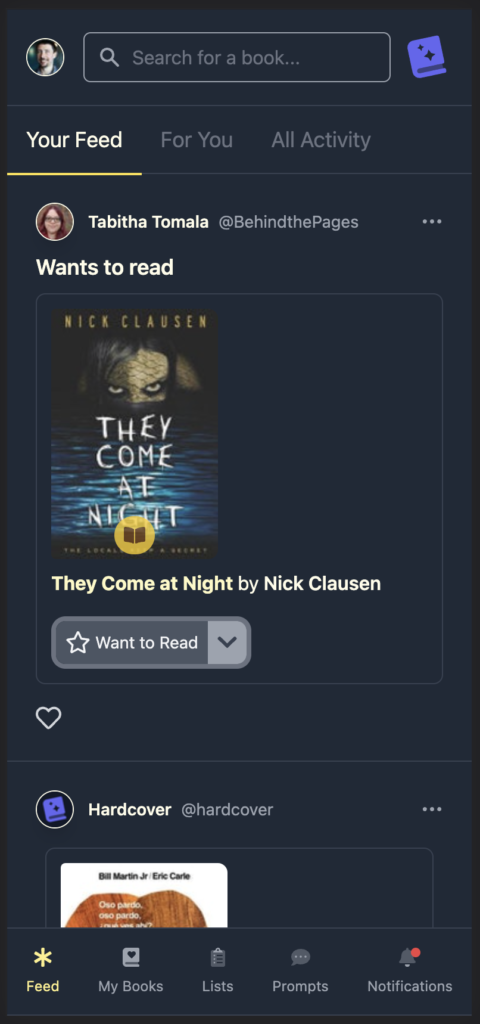
We have no doubt iOS and Android applications are in our future, but we’re not there yet. As we iterate, it’s easier to do that on the website than with an app. Once we stop iterating and understand what people use the most, that’ll be when we start a mobile app.
Winner: Goodreads
Which is Right for You?
Hardcover is still in beta, but we want to hear what you think! Describing any number of features isn’t going to be half as valuable as using Hardcover and seeing if does what you’re looking for.
Here’s what I’d recommend trying:
- Sign Up for Hardcover. We’re still in beta, but if you don’t mind the occasional dust and rough edges, you can start today.
- Import your library from Goodreads (or StoryGraph). We’ll import every book you’ve saved, your ratings, reviews, lists you’ve created and which books you marked as “owned”.
- Head over to your “Want to Read” page and sort your books by “Match Percentage”. This will show you the books Hardcover thinks you’ll love the most.
That’s just the start! You can answer a prompt, find a list of books you love, and follow some other readers with similar interests.
If you run into any issues, or have a wishlist of features you’d love to see, join our Discord community and let us know! We’re constantly discussing what we could build and basing it on community feedback.